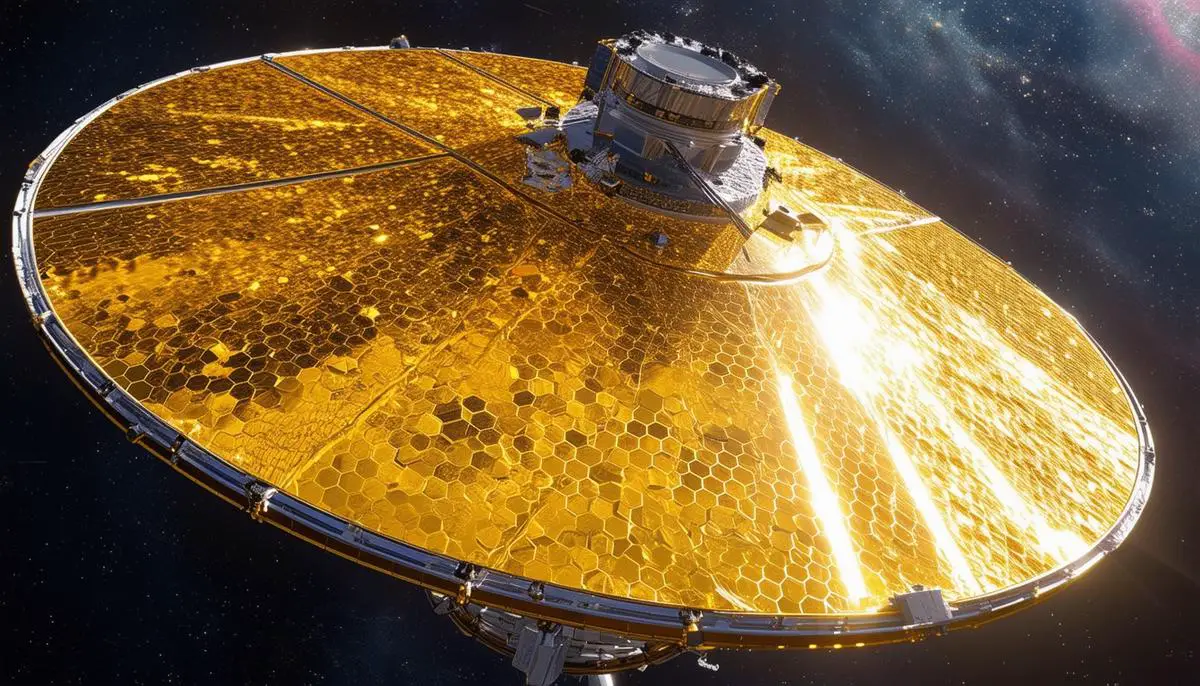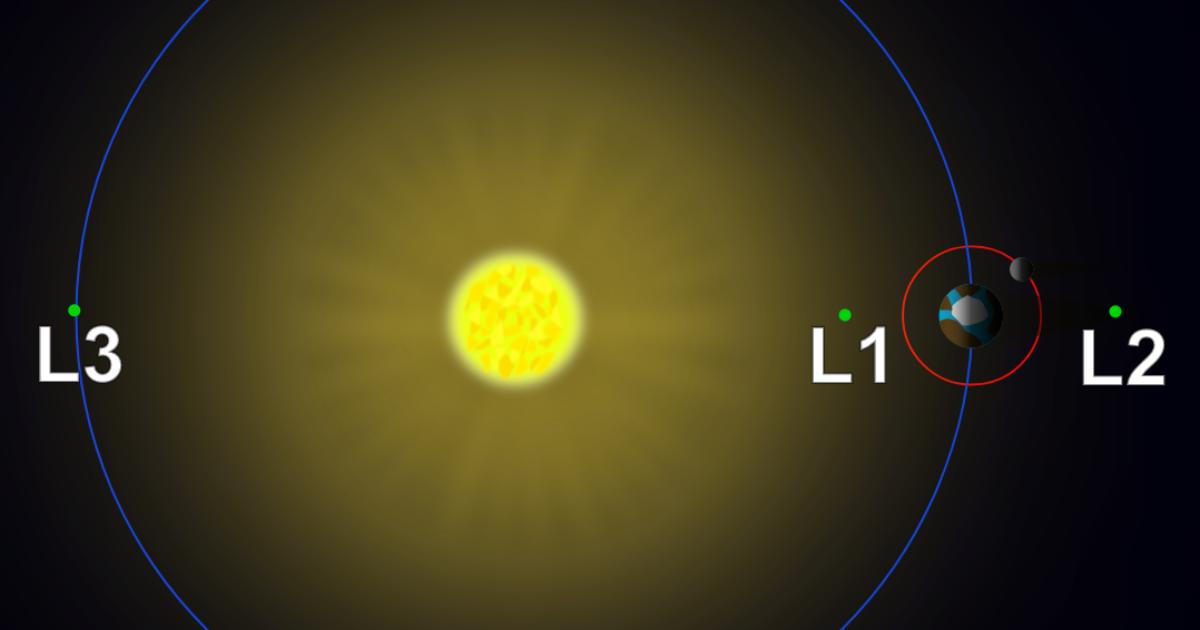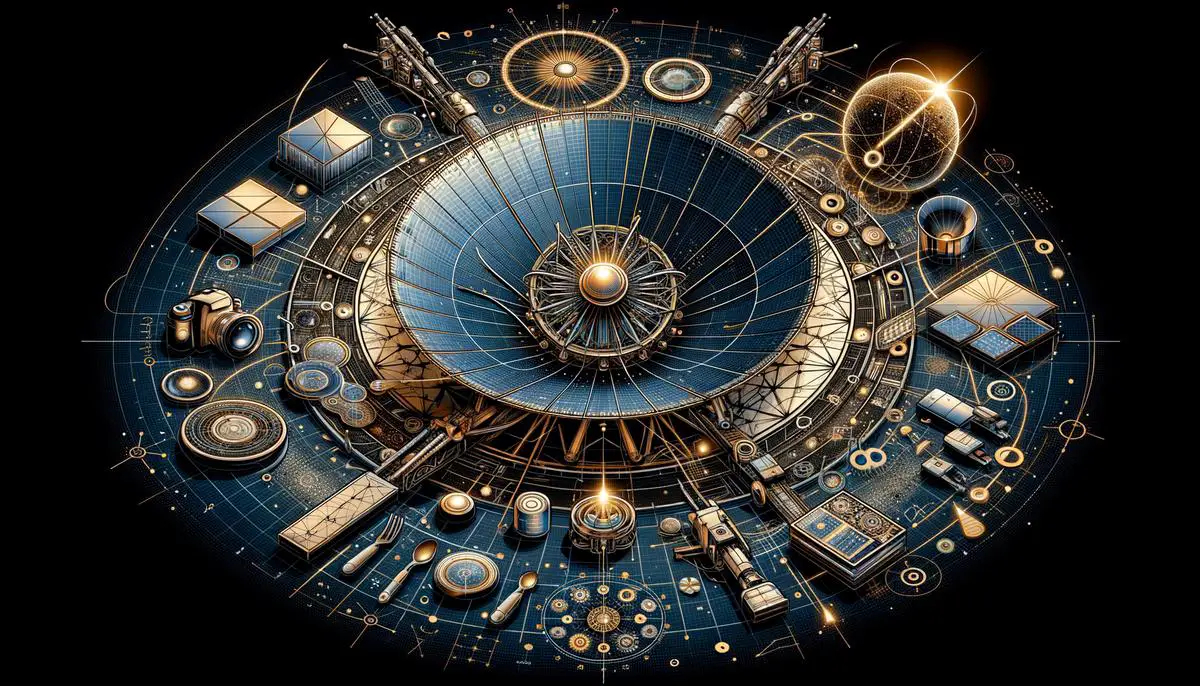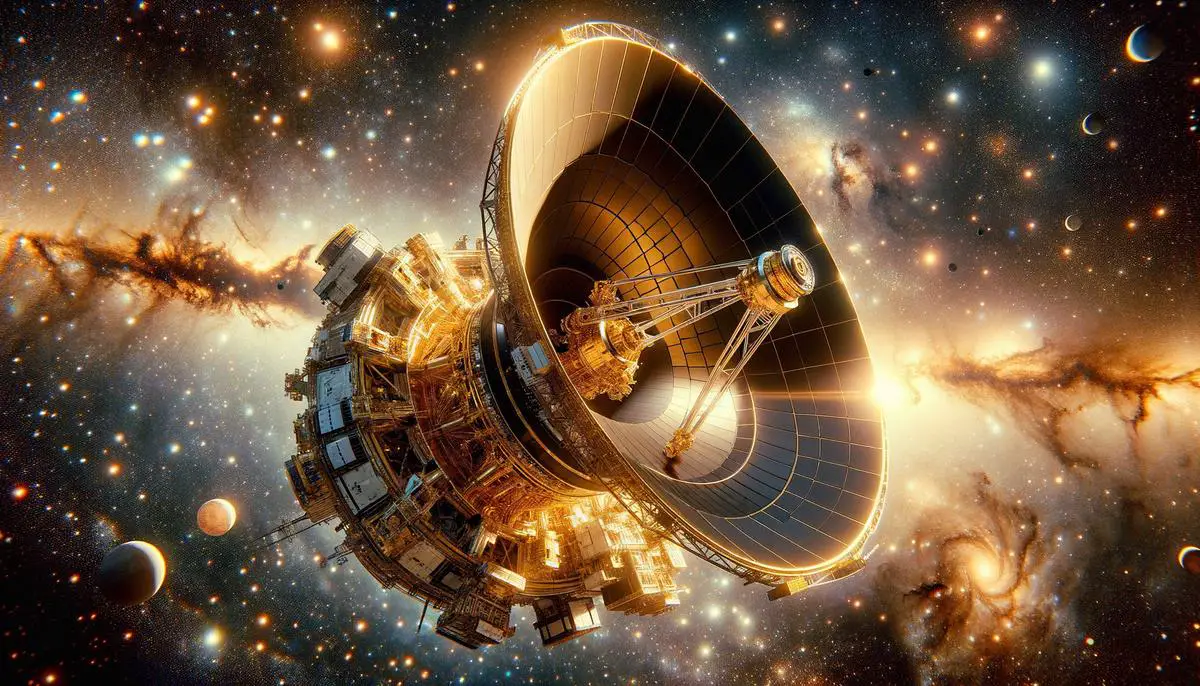Design and Deployment
The design of the James Webb Space Telescope (JWST) represents a significant leap in the engineering of space observatories. Incorporating an origami-style folding mechanism was essential for the telescope to fit within the constraints of the Ariane 5 launch vehicle. This ingenuity permitted the installation of a primary mirror notably larger than any previous space telescope, alongside a tennis-court-sized sunshield, both of which unfolded spectacularly following deployment.
At the heart of JWST's capabilities is its primary mirror, which spans 6.6 meters and consists of 18 hexagonal segments made from beryllium. Chosen for its stiffness and low thermal expansion at cryogenic temperatures, beryllium ensures precision and durability in the harsh environment of space. Each segment of this colossal mirror is coated in a minuscule layer of gold, roughly 100 nanometers thick, optimally reflecting infrared light and thereby capturing high-resolution images and spectra from the edges of the observable universe.
Supporting this giant mirror, the JWST's sunshield plays a crucial role in the telescope's functionality. Consisting of five layers made from Kapton—a material noted for its ability to withstand the extreme temperatures of space—this structure protects the telescope's instruments from the heat of the sun. By maintaining the observing instruments below 50 K (about -370°F), the sunshield ensures that JWST can detect faint infrared signals without interference from its own heat emissions.
Even the orbit of JWST, around the second Sun-Earth Lagrange point (L2), some 1.5 million kilometers from Earth, is specifically chosen. This location provides a stable gravitational point minimizing fuel use for course corrections and shields the telescope from light and thermal radiation from the Earth and Moon, improving observation quality.
The deployment of JWST in space was an extraordinary feat of engineering involving numerous unfurling and calibration stages. This precise setup was critical to ensure that each mirror and the sunshield reached their optimal alignment for accurate scientific work, demonstrating the dedication and expertise of a talented global team of engineers and scientists.

Scientific Instruments and Capabilities
The James Webb Space Telescope is equipped with four advanced scientific instruments designed to transform our understanding of the cosmos:
- Near Infrared Camera (NIRCam)
- Near Infrared Spectrograph (NIRSpec)
- Mid-Infrared Instrument (MIRI)
- Fine Guidance Sensor/Near InfraRed Imager and Slitless Spectrograph (FGS/NIRISS)
Each plays a critical role in Webb's mission by capturing high-resolution images and spectra across a broad spectrum of infrared light.
NIRCam serves as Webb's principal imaging component, operating primarily in the near-infrared spectrum. It is designed to capture sharp images, employing processes like wavefront sensing and coronagraphy to enhance our insight into the universe's structures. NIRCam's capabilities are pivotal in the hunt for the earliest galaxies, as well as observing stars in formation in our local neighborhood and beyond. This instrument's large field of view coupled with sensitive detectors allows it to observe faint objects with unprecedented resolution, transforming mere points of light into windows to the early days of the cosmos.
Next, NIRSpec augments JWST's observational prowess by dissecting the light from celestial objects into their constituent spectra. This capacity is fundamental for identifying chemical compositions, temperatures, and redshifts of distant objects. NIRSpec's expansive multi-object spectroscopic functionality lets it observe up to 100 objects simultaneously, dramatically increasing Webb's efficiency in gathering spectral data across expansive patches of the sky. Studied spectra reveal vital clues about the physical properties of stars and galaxies billions of light-years away and probe the atmospheres of exoplanets, potentially identifying signs of habitability or even life.
MIRI is a unique instrument capable of accessing the universe in mid-infrared wavelengths, which are crucial for peering into colder regions of space where stars are being born within dense dust clouds, and for studying protoplanetary discs, comets, and newly formed planets. MIRI combines both imaging and spectroscopy, uniquely qualifying it to analyze the physical and chemical properties of cosmic dust, apart from capturing pristine cosmic landscapes haunted by stellar births. Its ability to detect mid-infrared light unveils objects impossible to see with instruments limited to visible or near-infrared observations.
Lastly, FGS/NIRISS fulfills a dual role; it notably stabilizes the telescope's line of sight, allowing its finer observational instruments to focus unfalteringly on cosmic features, often trillions of miles distant. Simultaneously, NIRISS ushers in a swath of scientific opportunities through its broad-spectrum, slitless spectroscopy and advanced imaging capabilities. Particularly adept at examining the atmospheres of exoplanets, NIRISS plays a pivotal role in dissecting the light passing through exoplanetary atmospheres—disclosing vital data about their composition and weather patterns.
Together, these instruments provide JWST with unmatched sensitivity and precision, fortifying our quest to understand the genesis and evolution of the universe from near solar neighborhood events such as star formation to the most ancient reaches of the cosmic frontier. These instruments act as our refined sense extending deeply into the cosmic vista, hunting for answers to age-old questions about the universe and our place within it.
Mission and Orbit
Launched with the mission to unfold the mysteries of the universe, the James Webb Space Telescope (JWST) is a marvel of modern astronomy and a beacon into the depths of space and time. Its primary mission objectives span a diverse range, aimed at:
- Unearthing the universe's earliest luminous beginnings
- Scrutinizing the formation and growth of galaxies
- Unlocking the intricacies of star birth and death
- Closely investigating the atmospheres of exoplanets which may harbor conditions favorable for life
Central to fulfilling these ambitious scientific missions is JWST's unique orbit around the second Sun-Earth Lagrange point, commonly referred to as L2. This specific point in space offers a stable gravitational balance derived from the relative motions of the Earth and Sun. Positioned approximately 1.5 million kilometers from Earth, L2 serves as an ideal backdrop against which the sensitive instruments of the Webb can achieve their maximum observational capacity without the interference of Earth's atmosphere or thermal emissions.
Choosing L2 as JWST's celestial perch brings manifold benefits. It permits the telescope to maintain a relatively constant position with respect to Earth, simplifying communication and data relay. Consistently facing away from the Sun, Earth, and Moon, the Webb can utilize its sunshield effectively, ensuring critical instruments are kept at optimal low temperatures needed for infrared observations. This orientation also prevents the Sun, Earth, or Moon from entering its field of view, which could otherwise cause glaring light that might disrupt Webb's sensitive observations.
Additionally, this special orbit enables almost continuous observation of the cosmos. Unlike telescopes that orbit the Earth and constantly move in and out of Earth's shadow, JWST's orbit allows it to have an unobstructed view, enabling prolonged and continuous observation periods. This is crucial when observing faint objects or events requiring extended monitoring, such as the delicate processes of planet formation or stellar dynamics in distant galaxies.
The tranquility of L2 avoids major gravitational perturbations, granting Webb a stable route with minimal fuel consumption for positional adjustments. This stability is pivotal for the high precision required in photometry and astrometry—the measurement of light intensity from celestial bodies and their positions in space, respectively. It ensures that observations are long-term and incredibly precise, grasping details at unprecedented clarity.
Through this strategic positioning at L2, the James Webb Space Telescope is impeccably aligned to cast light on the darker corners of universe questions that have lingered among the stars unanswered. This pathway JWST traces around L2 isn't only an orbit but a carefully orchestrated dance in the symphony of celestial research, harmonizing the cosmos' secrets with our ever-evolving cosmic curiosity.

Major Discoveries and Contributions
Since its deployment, the James Webb Space Telescope (JWST) has been piercing through the cosmic veils to unveil a breathtaking portfolio of astronomical phenomena, reshaping our comprehension of the universe's intricacies. The array of groundbreaking discoveries already accomplished by the JWST spans across various facets of cosmic inquiry, revolutionizing astrophysics and enriching our understanding of the universe.
Among its celestial triumphs, JWST has provided us unprecedented views of the farthest galaxies ever observed, elucidating the formation and evolution of these structures closer to the dawn of time than was previously possible. This image collection includes galaxies that serve as critical tests to our ongoing evolution models. They exhibit mature stars and heavy elements which prompt a reevaluation of when and how galaxies formed in the early universe. These observations suggest galaxies were formed earlier and matured quicker than our theoretical frameworks anticipated.1
Adding layers to the scope of its scientific impact, Webb's aptitude for peering into the atmospheres of exoplanets has yielded significant results, advancing our explorations into the potential habitability and composition of these distant worlds. For instance, JWST detailed atmospheric scans identified evidence of water vapor, carbon dioxide, and even signs of active chemistry possibly conducive to life in some exoplanet atmospheres.2 Such precise measurements feed into broader discussions in astrobiology and the ongoing hunt for potentially habitable worlds among the cosmos.
In addition to observing distant galaxies and exoplanets, JWST has a keen ability to scrutinize stellar life cycles, including the birth and death of stars. Through its infrared gaze, JWST presents observations of stellar nurseries shrouded in cosmic dust, impossible for previous telescopes to penetrate.3 Similarly, the telescope watches over dying stars, cataloguing detailed information on the processes that may lead to the dispersal of elements necessary for life into the surrounding universe.
These preliminary results have already demonstrated a significant impact on our understanding, confirming some theories while challenging others. The detailed data captured by Webb's instruments have the potential for reconstructing segments of cosmic history and revising long-standing narratives.
The Webb Telescope's dedication to its mission objectives reveals a universe richer and perhaps more complex than previously known. Each set of data illuminates some mysteries of our vast universe while also raising new questions that challenge the scientific community. With the JWST attuned to capture the cosmic symphony, its scientific mission promises to deepen our understanding of the universe with each pass of its mirrors through the ancient light of distant stars.
Challenges and Innovations
The array of technical and logistical challenges surrounding the James Webb Space Telescope (JWST) provided numerous opportunities for innovation within aerospace technology and operational software, driven by the unprecedented complex mission demands.
One of the paramount challenges was the design and construction of the telescope, which mandated new levels of precision engineering and integration. The JWST's components, including its mirrors and sunshield, required fabrication within microscopic tolerances. Given these components had to perform flawlessly in the extreme conditions of space, this pushed the boundaries of materials science. For instance, the JWST's mirrors are made of beryllium—a material selected for its rigidity and stability under extreme temperatures—sourced from unique earthly locations and processed with advanced technologies to achieve the desired properties.4
Coating these mirrors with an ultra-thin layer of gold to optimize their reflectivity for infrared light involved innovative vapor deposition techniques. Each of these processes elevated the telescope's design and pushed forward the boundaries of how materials can be manipulated while maintaining stringent space-grade quality standards.
Early in its conceptual stages, another challenge was identifying an orbit that would fulfill all of JWST's observational requirements while remaining technically feasible and logistically sustainable. The decision to place Webb at the L2 point—a position never before used for such a large and complex observatory—vastly influenced subsequent strategy pertaining to mission design, propulsion, and communication.
Deployment posed significant risks given the intricacy of unfolding the telescope's primary mirror and sunshield accurately in space—a procedure that could not be fully tested on Earth due to gravitational differences. To address this, engineers developed sophisticated simulation software programs, leading to substantial innovations in virtual testing environments.5 These programs utilized advanced algorithms to predict and visualize every possible outcome during the telescope's deployment sequence, ensuring any potential issues could be mitigated proactively.
The unique orbit also demanded innovative solutions for power generation, thermal management, and data transfer. A high-gain antenna capable of maintaining communication over about a million miles had to be developed, ensuring the timely and efficient transfer of vast amounts of astronomical data.
Solar panel technology saw enhancements, improving their efficiency and stability at greater distances from the sun. Thruster technology also saw advancements, achieving more precise maneuvers for maintaining Webb's halo orbit around L2 while minimizing fuel consumption—a critical consideration for prolonging the spacecraft's operational life.
The synthesis of these challenges and innovations advanced the specific mission parameters of the JWST and contributed broadly to our capabilities in space technology and exploration. Each solution provided pathways for further technologies in aerospace, deepening our understanding and capabilities beyond the immediate needs of Webb's mission. Undeniably, the JWST is a testament to human ingenuity when confronted with the vast, unyielding mysteries of space, standing as a beacon of both contemporary accomplishment and future potential in cosmic exploration.

- Robertson BE, Ellis RS, Furlanetto SR, Dunlop JS. Cosmic reionization and early star-forming galaxies: a joint analysis of new constraints from planck and the hubble space telescope. Astrophys J Lett. 2015;802(2):L19.
- Morley CV, Kreidberg L, Rustamkulov Z, Robinson T, Fortney JJ. Observing the atmospheres of known temperate earth-sized planets with JWST. Astrophys J. 2017;850(2):121.
- Dauphas N, Schauble EA. Mass fractionation laws, mass-independent effects, and isotopic anomalies. Annu Rev Earth Planet Sci. 2016;44:709-783.
- Lightsey PA, Atkinson CB, Clampin M, Feinberg LD. James webb space telescope: large deployable cryogenic telescope in space. Opt Eng. 2012;51(1):011003.
- Arenberg J, Matthews G, Atkinson C, et al. Thermal testing of the JWST telescope. Proc SPIE Int Soc Opt Eng. 2014;9143:91430S.
![]()
